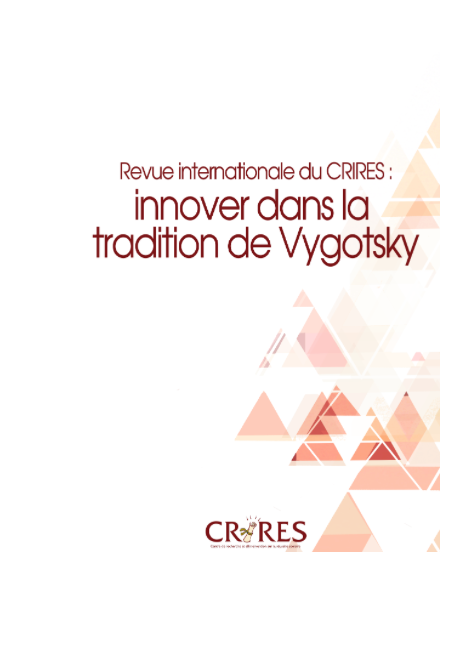Une modeste révision de la représentation de la théorie des systèmes d’activité
DOI:
https://doi.org/10.51657/ric.v1i1.41019Keywords:
Activity system theory, Mediation, Collectivity, Development, ContradictionAbstract
A revision of Activity Systems Theory is proposed, one that moves from the familiar two-dimensional triangular representation to a novel three-dimensional tetrahedral representation. Such a revision from two to three dimensions offers a number of advantages: highlighting the synergy among meditational means, and the requirement of reciprocal growth to achieve effective activity, supporting analysis of imbalances in meditational means that interfere with activity, clarifying the relationships among the four fields of activity, and better integrating Activity Systems Theory with Vygotsky’s original formulation of activity as consisting of joint sign and tool mediation. The tetrahedron representation is a promising heuristic for advancing theory and study of human activity.
References
Barma, S. (2008). Un contexte de renouvellement des pratiques en éducation aux sciences et aux technologies : une étude de cas réalisée sous l'angle de la théorie de l'activité. Université Laval, Québec.
Barma, S. (2011). A sociocultural reading of reform in science teaching in a secondary biology class. Cultural Studies of Science Education, 6(3), 635-661. Récupéré de : http://www.springerlink.com/content/ 59n73m86g140978h/
Becker, H. J., et Riel, M. M. (2000). Teacher professional engagement and constructivist-compatible computer use. (Report No. 7) Irvine, CA et Minneapolis, MN: Université de Californie, Irvine et Université du Minnesota: Teaching, Learning, and Computing : 1998 National Survey. Center for Research on Information Technology and Organizations.
Bracewell, R. J. et Witte, S. P. (2008). The implications of practice, activity, and semiotic theory for cognitive constructs of writing. Dans J. Albright and A. Luke (dir.), Pierre Bourdieu and Literacy Education. Mahwah (pp. 299-316). NJ: Lawrence Erlbaum Associates.
Bracewell, R. J. et Witte, S. P. (2003). Tasks, ensembles, and activity: Linkages between text production and situation of use in the workplace. Written Communication, 20, 511-559.
Engeström, Y. (1987). Learning by expanding : An activity theoretical approach to developmental research. Helsinki : Orienta-Kousultit.
Ertmer, P. A. (2005). Teacher pedagogical beliefs : The final frontier in our quest for technology integration. Educational Technology Research and Development, 53, 25-39.
Harris Interactive. (2008). The MetLife Survey of the American Teacher : Past, Present and Future. Metropolitan Life Inc.
Hutchins, E. (1995). Cognition in the Wild. Cambridge, MA : MIT Press.
Larose, F. et Karsenti, T. (2002). La place des TIC en formation initiale et continue à l'enseignement: Bilan et perspectives. Sherbrooke, Québec : Editions du CRP.
Leont’ev, A. N. (1978). Activity, consciousness, and personality (M. J. Hall, Trad.). Englewood Cliffs, NJ : Prentice-Hall. (Publication originale russe en 1975)
Park, J. (2009) Designing a well-formed activity system for an ICT-supported constructivist classroom: A Cultural-Historical Activity Theory perspective. Thèse de doctorat, Université de McGill.
Park, J. et Bracewell, R. J. (2008). Designing a well-formed activity system for an ICTs-supported classroom Dans J. Zumbach, N. Schwartz, T. Seufert, et L. Kester (Dir.), Beyond knowledge : The legacy of competence in meaningful computer-based learning environments (pp. 101-110). New York : Springer Science.
Park, J., Sicilia, C. et Bracewell, R. J. (2009). The role of contradictions in the development of technology-supported constructivist classroom practices: A cultural-historical activity theory perspective. Educational Technology International, 10(1), 1-10.
Vygotsky, L. S. (1987). Thinking and speech (N. Minick, Trans.). Dans The collected works of L. S. Vygotsky, Vol. 1: Problems of general psychology (R. W. Rieber et A. S. Carton, Dir.) (Publication originale russe en 1934 Myschlenie i rechí, pp. 39-285, 375-384, 387-389). New York : Plenum.
Vygotsky, L. S. et Luria, A. R. (1994). Tool and symbol in child development (A. R., Luria et M., Cole, Trad.). Dans R. van der Veer et J. Valsiner (Dir.), The Vygotsky reader (pp. 97-174). Oxford : Blackwell.
Downloads
Published
Issue
Section
License
Copyright (c) 2013 Robert J. Bracewell, Jonghwi Park

This work is licensed under a Creative Commons Attribution-NonCommercial-NoDerivatives 4.0 International License.

